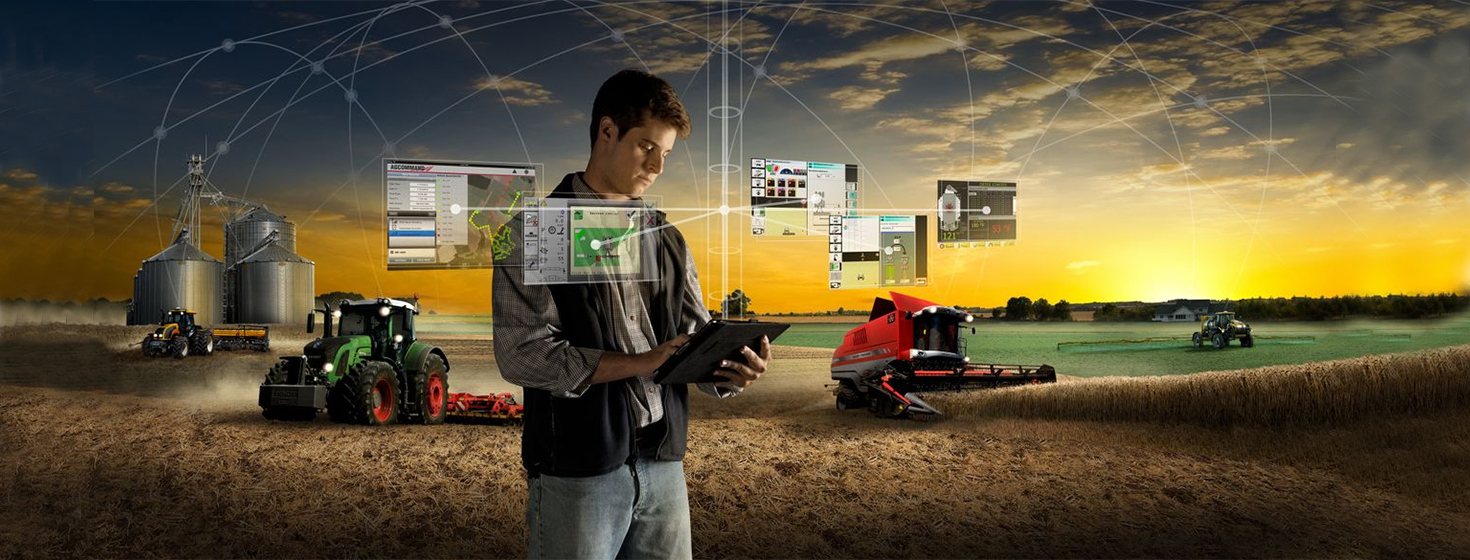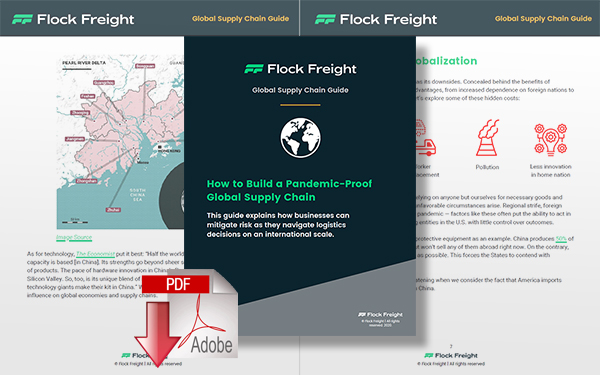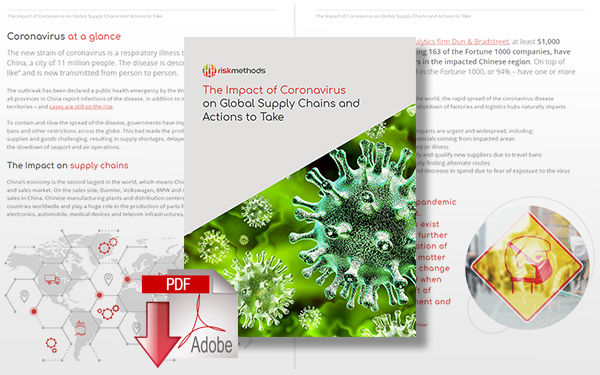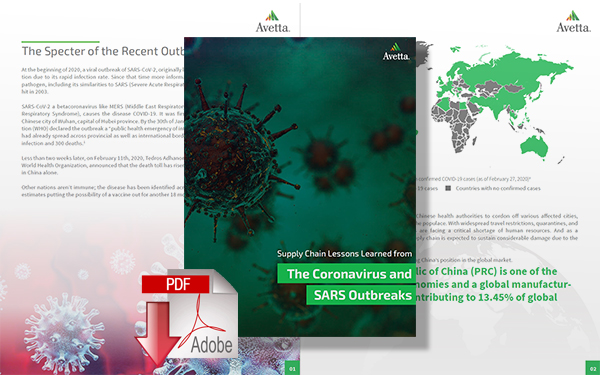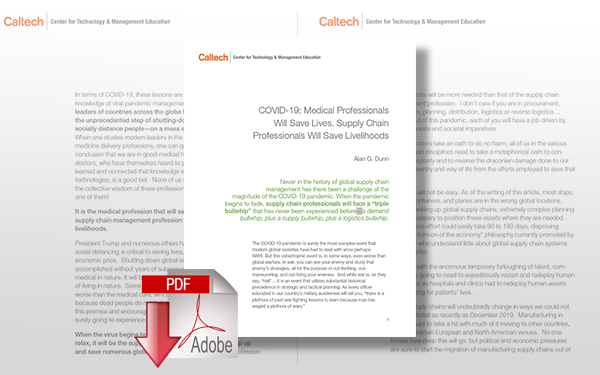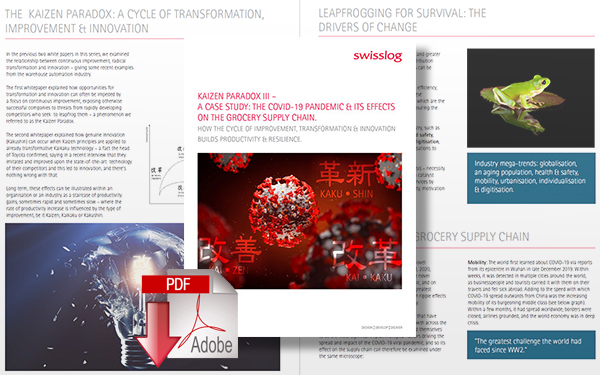Differences between the COVID-19 Pandemic and Other Supply Chain Disruptions

Supply chain leaders should prepare for additional disruptions in supply and transportation due to the coronavirus pandemic, but if you are a business chain leader, what are some things you could do right now?
Supply Chain Risk Management
This morning, I taught my first full class in front of a computer instead of in front of my students.
Like nearly all universities, Penn State has canceled in-person classes and is moving to remote/online instruction.
My class is for seniors majoring in supply chain management, and it is (and will be) somewhat awkward to teach a case-based discussion course online.
Per the syllabus, the already scheduled topic of supply chain risk management is taking on a whole new urgency for many firms, industries, and society as a whole with the spread of COVID-19.
It seemed like a good time to share some of what we are and will be talking about in class with our supply chain partners.
A caveat: My research expertise is in supply chain decision-making; with Christopher Craighead, now at the University of Tennessee and a Supply Chain Management Review contributor, I co-wrote a popular case about how firms can deal with a supply chain disruption. Yet, that focused on the bankruptcy of a supplier and the impact on a tier-1 firm.
Today the news is about Disruption with a capital “D.” So, what are some of the differences between COVID-19 and other disruptions? There could be more, but I discuss seven dimensions here, which are summarized in Table 1 below.
Geography. In most cases, a supply chain disruption is limited to a region or country. For example, we are used to hurricanes hitting Florida, or earthquakes in California. This past year, we saw massive wildfires in Australia. No one should discount the suffering after natural disasters like Hurricane Katrina in New Orleans and other areas.
Yet one difference with a pandemic like COVID-19 is that it is hitting the entire world. This is important because, under normal circumstances, resources from one region can support affected regions. For example, utilities send repair crews in from out of state, and even firefighters and equipment from the United States recently assisted in Australia. This is very difficult to do when everyone is simultaneously affected.
Scope. Beyond geography, COVID-19 has nearly unprecedented scope. In an ordinary disruption, we might see a few key industries knocked offline for weeks or months: Hurricane Harvey took much of the U.S. Gulf Coast petrochemical industry offline for several weeks, yet West Coast refineries were not affected.
What's unique about COVID-19 is that it is affecting both goods and services. Clearly there is increased demand for masks and hand sanitizer, so it is logical that those items would be in short supply.
However, there is fundamentally no increase in demand for toilet paper, so shortages there are unusual and related to human behavior. But, the impact of COVID-19 is that demand for services is greatly diminished. We cannot stockpile an inventory of services or experience goods, so those are, at best, delayed. This includes things like the cancellation of all sporting events, idled cruise ships, empty hotel rooms, and the widespread cancellation of airline flights.
In addition, most shops and restaurants are closed. The week before I wrote this article and before the official shutdown, I went into my local barbershop (as yet we had no COVID-19 cases reported in my county or nearby). There were six employees standing outside; I was the only customer in the shop the whole time. Here in State College, much of the economy revolves around university students, all of whom are now staying home. All of this will have knock-on effects throughout the entire economy.
Demand vs. supply. Many supply chain disruptions affect supply. I have already mentioned several, and today in class the previously assigned reading was about a well-known fire in a Philips Electronics chip plant in 2001 and the impact on major mobile phone makers Nokia and Ericsson. At the time, Nokia had 27% of the global cell phone market and Ericsson had 12%. Lightning struck the Philips plant, causing a loss of chips, yet the real damage was that the plant was contaminated and could no longer produce chips for these and other firms. However, how Nokia responded was unique - with fast communication, an all-hands-on-deck approach, and coordination that saw them weather the storm with minimal disruption. Ericsson took a much slower approach and was far more vulnerable to this supply disruption.
In the end, Nokia gained 3% of the global cell phone market (mostly from Ericsson), and subsequently, Ericsson ended up exiting the handset business. There have been some supply disruptions due to COVID-19 and there will be more disruptions in manufacturing, distribution, and transportation in the upcoming weeks.
Table 1: Dimensions of Supply Chain Disruptions for COVID-19

However, COVID-19 is (and will be) affecting demand. Perhaps you have seen news reports about major airlines canceling all international flights, and 40% of their domestic capacity. Beyond this, demand will be affected even when there is virtually no disruption in supply. For example, look at the Fukushima Daiichi nuclear disaster following the earthquake and tsunami in Japan in 2011. Shortly after the disaster, luxury goods maker LVMH closed 50 stores in Japan. The supply chain for high-end merchandise was relatively unaffected, yet few people wanted to be seen with a new Louis Vuitton handbag when tens of thousands of their neighbors were suffering. Other luxury brands were similarly affected.
In the case of COVID-19, the size and duration of the impact are not clear. For example, one can easily imagine that the demand for new cars will decrease, both because some individuals may lose their jobs or see hours cut and understandably reduce their spending. Yet demand will also decrease because the perception of conspicuous consumption of new goods is likely to mute demand in the face of a global disaster.
Prior planning and experience. For many disruptions, planning and prior experience are guides. For example, factories in the Midwest and elsewhere have tornado-safe locations for their employees. Elementary schools regularly practice fire and tornado drills. Refineries in the Gulf Coast plan for hurricanes and hospitals have emergency generators. Yet there is limited prior planning for a global pandemic such as COVID-19. Yes, the United States is supposed to maintain a strategic stockpile of ventilators and other supplies, yet, as we are learning, no amount of inventory would be sufficient under the worst-case scenarios.
Perhaps more important than inventory and planning is the lack of experience: Experts refer back to the 1918 Spanish Flu outbreak for guidance, yet no public health experts have personal experience with this type of global pandemic. (The historical contrast between Philadelphia and St. Louis is telling, as the former went ahead with a large, public parade with after which thousands of additional individuals became infected with influenza; St. Louis experienced far fewer cases and deaths after implementing quarantine procedures.) Of course, it’s a good thing that we do not regularly have pandemic events, yet that makes these unprecedented times for firms, world leaders, and individuals who are learning in real-time the best steps to take.
Financial system. Most often, when there is a major disruption, the financial impact is relatively contained. Events such as Pearl Harbor and 9/11 saw a comparably small impact to the stock market. The closest thing might be the global Financial Crisis in 2007-2008. Yet, that crisis had a comparatively limited supply chain impact. If anything, there was more supply and less demand, yet there were no major, sustained disruptions to production or transportation networks.
In contrast, we have seen global stock markets crash, and central banks and governments undertake unprecedented actions to support the economy. The reason for this is that the COVID-19 demand shock is leading to financial disruption. If this goes on, we will continue to see small businesses cut employees or close and many firms will have difficulty raising capital or repaying loans - preserving cash will be crucial.
Term. For most disruptions, the term is limited - or is at least quantifiable. For example, most disasters see short-term demand for rescues or emergency services immediately after an event. However, the term for COVID-19 is relatively unknown. We have seen a significant spike in the demand for hospital beds and ventilators, and social distancing is working in some areas to keep the number of infections below the system capacity. While most large disruptions have a defined short- or medium-term that can be fairly accurately predicted, the term for a global pandemic is long and uncertain.
Human impact and behavior. For the majority of disruptions, the human impact is relatively limited. Naturally, there are immediate and consequential injuries following a natural disaster. Yet, these are limited by location and are somewhat understandable: Natural disasters can be terrifying, but fear largely subsides when they are over. In contrast, COVID-19 has many unknowns. Most of us are not infected, but it is still very natural to be concerned for family members, friends, co-workers, and heroic first-responders. We do not know how long this will last, nor what the consequences will be. I doubt that many of us would prefer to live through a major tornado over practicing social distancing, yet we should not discount the impact on behavior. That is perhaps one reason for increased demand for toilet paper: People feel the need to do something to prepare, even if the underlying consumption of toilet paper remains constant.
Other impacts. There can more COVID-19 effects. For example, many pharmaceuticals and machine parts are made in Switzerland, and these are regularly shipped worldwide in the cargo space of commercial airliners. If the global air network is disrupted over the long-term, this could lead to shortages or other impacts. In addition, firms and governments are likely to reconsider their supply chains to reduce systemic risk. There will be considerable work to re-design supply chains to improve resiliency. Much of the global pharmaceutical industry relies on materials made in China, and many industries (like automotive) have complex supply chains. All of these relationships will need to be re-examined.
What Leaders Should Do
Supply chain leaders should prepare for additional disruptions in supply and transportation. Yet if you are a business chain leader, what are some things you could do right now? There are some strong resources on supply chain risk management, but most resources focus on developing a resilient supply chain and have less to do with facing an immediate crisis. As I told my students this morning, these are unprecedented times, yet we will get through these by working together and with flexibility. This is unlikely to be the last supply chain disruption, though it is likely to be one of the most memorable. Each of us should listen to public health authorities and do what we can to keep in mind the unique circumstances.
Beyond that, consider three additional steps: First and foremost, take care of your people, including employees and customers. Employees will likely need to be reassured about what is happening at your firm, so maintain effective communication. If anything, over-communicate, especially if there are significant changes to regular operations. Provide opportunities for employees to talk with you or their manager. Support your customer-facing employees and logistics personnel who must keep working when others are in quarantine.
Second, be flexible, and encourage flexibility. There will be inevitable disruptions as schools remain closed, and more individuals contract or care for those with COVID-19. Letting people know they should remain home if they feel ill or are in contact with someone who has the virus is key.
Third, this is a good time to review and update emergency plans and contact information. Make sure several layers of backup employees are available for key activities and update emergency contact lists so that these backup employees can communicate with others. Finally, months or years from now, employees and customers are unlikely to remember what you said, but they are likely to remember how they felt. Act accordingly.
I. Latour. 2001. A Fire in Albuquerque Sparks Crisis For European Cell-Phone Giants. The Wall Street Journal; New York, N.Y.; Jan. 29, 2001, p. A1
II. Helper, Gray, and Osborne. March 16, 2020. Retooling US Supply Chains to Address Weaknesses Exposed by new Coronavirus. Washington Center for Equitable Growth.
III. Some recommended additional resources include the following: Melnyk, Closs, Griffis, Zobel, and Macdonald. 2014. Understanding Supply Chain Resilience. Supply Chain Management Review. Jan/Feb 2014 Chopra and Sodhi. 2004. Managing Risk to Avoid Supply Chain Breakdown. MIT Sloan Management Review, Fall 2004, pp. 53-61 Sheffi, Y. 2005. The Resilient Enterprise: overcoming vulnerability for competitive advantage. MIT Press Books.
About the Author
Brent Moritz, Ph.D. is an associate professor of supply chain management at the Smeal College of Business, The Pennsylvania State University. He can be reached at [email protected].
Related: AGCO’s Supply Chain Risk Management & Strategic Sourcing Strategies - Pandemic Lessons for Everyone
Related White Papers
How to Build a Pandemic-Proof Global Supply Chain
This guide explains how businesses can mitigate supply chain risk, including the latest coronavirus pandemic, as they navigate logistics decisions on an international scale. Download Now!
The Impact of Coronavirus on Global Supply Chains and Actions to Take
In this paper, we discuss the ins and outs of the coronavirus, with a focus on the effects the disease can - and is - having on global supply chains, and what actions you can take. Download Now!
Supply Chain Lessons Learned from The Coronavirus and SARS Outbreaks
This white paper contains insights from recent interviews with leading organizations on how they are responding to the new coronavirus crisis. Download Now!
COVID-19: The Supply Chain Management Professionals That will Save Our Economies and Livelihoods
Never in the history of global supply chain management has there been a challenge of the magnitude of the COVID-19 pandemic…when the pandemic begins to fade, supply chain professionals will face a “triple bullwhip” that has never been experienced before. Download Now!
The COVID-19 Pandemic and Its Effects on the Grocery Supply Chain
This white paper examines how Lights-Out Logistics has come into use, and how it can help our supply chains become more resilient in times of great uncertainty and disruption, such as pandemics and financial crises. Download Now!
More Resources on Supply Chain Risk Management
Article Topics
Penn State Smeal College of Business News & Resources
Supply Chain Education in the Post-COVID World Differences between the COVID-19 Pandemic and Other Supply Chain Disruptions 2019 Third-Party Logistics Study: The State of Logistics Outsourcing The 21st Annual, 2017 Third-Party Logistics Study Armstrong & Associates 2017 Top 50 U.S. and Global Third-Party Logistics Providers A Wide-Ranging Look at the Role of Third-Party Logistics in Different Supply Chain Areas 2016 Third-Party Logistics Study More Penn State Smeal College of BusinessLatest in Supply Chain
Porsche Gets Greener, Shifts to Sustainable Transport Logistics How Much Will it Cost to Repair Baltimore’s Francis Scott Key Bridge? Retailers Take Lead in Big-Box Warehouse Leasing, CBRE Finds Trucking Industry Pushes Back on Government’s Electric Mandates Senators Take Aim at Amazon with Warehouse Worker Protection Act Maersk Sees Silver Lining in Red Sea Shipping Challenges Happy Returns Partners With Shein and Forever 21 to Simplify Returns More Supply Chain

